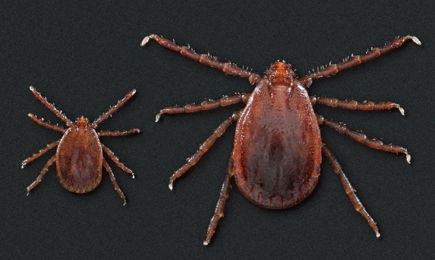(WJW) — An invasive species of tick known as the Asian longhorned tick, found in at least 18 states, including West Virginia, has been rapidly spreading across Ohio.
According to scientists from The Ohio State University, the ticks originally arrived in 2021. The ticks are believed to be responsible for the death of three cattle due to severe blood loss, according to Ohio State researchers.
Scientists from The Ohio State University are now conducting research focused on monitoring and managing these pests.
“They are going to spread to pretty much every part of Ohio and they are going to be a long-term management problem. There is no getting rid of them,” said Risa Pesapane, senior author of the paper and an assistant professor of veterinary preventive medicine at Ohio State.
“The good news about the ticks, though, is that most tick control agents that we currently have seem to kill them. Still, managing them is not easy because of how numerous they are and how easily they can come back.”
Originating from East Asia, the Asian longhorned tick was first confirmed in the U.S. in 2017, but the U.S. Department of Agriculture says it may have been here since 2010 or earlier. As of September 2023, the USDA reports the ticks have also been confirmed in Arkansas, Connecticut, Delaware, Georgia, Indiana, Kentucky, Maryland, Massachusetts, Missouri, New Jersey, New York, North Carolina, Pennsylvania, Rhode Island, South Carolina, Tennessee, Virginia, and West Virginia.
The longhorned ticks appear to enjoy being in a group, as thousands may be found at a time in grass, shrubs, or on animals, according to the CDC. The Asian longhorned ticks possess a unique ability to reproduce asexually, with each female capable of laying up to 2,000 eggs. Moreover, all offspring can reproduce in the same manner, allowing for exponential population growth.
The ticks appear to be less attracted to humans than native ticks, the CDC explains, but have shown a preference for livestock and wildlife including cattle, deer, horses, goats, opossums, raccoons and mice, among other animals. According to the USDA, the tick — about the size of a sesame seed — has also been found on birds such as owls and hawks.
The first tick in Ohio was found on a stray dog on a farm in Gallia County in 2020. During investigations, researchers collected nearly 10,000 ticks within a short period from the infested farm, leading to an estimate of over 1 million ticks in the about 25-acre pasture.
Ohio researchers say they have also identified the tick-borne illness Anaplasma phagocytophilum in a small number of the ticks, which can cause diseases in both animals and humans. Additionally, cases of bovine theileriosis, caused by a pathogen carried by these ticks, have been reported in Ohio, according to the study.
The CDC says a recent study found that the longhorned tick is “not likely to contribute to the spread of Lyme disease in the United States.”
If you believe you’ve found an Asian longhorned tick on you, another person, or an animal, you should remove it as quickly as possible. Then, contact your health department or veterinarian for the next steps, the CDC advises. If you are concerned about the ticks impacting your livestock, contact your state or local agriculture office.
While newly introduced tick species are of great concern, I wish someone would address the explosion of existing tick and chigger populations in Appalachia. While there have always been both here, there are no doubt 100x more now than a decade ago. You could walk then in the woods and fields with only minimal risk of picking up parasites. Now it is a certainty you’ll be eaten alive. Of special concern are deer ticks -primary vector of Lyme Disease. I never saw a single one growing up here. Now they are everywhere and active at all times it is above freezing. Surely warmer winters are a driver. I hate to advocate for a genetic solution such as the ones demonstrated for mosquitoes, but these parasites are totally out of control now.



